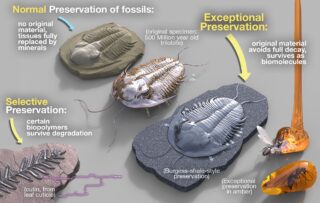Exceptional Preservation of Fossils
ARC Laureate Fellowship Project
Interpreting the molecular record in extraordinarily preserved fossils: An unexplored archive of Earth’s environment over geological time
This Laureate project aims to unlock an untapped record of our planet’s past, by analysing fossils for new evidence of natural products, in the form of preserved biochemicals or their recognisable degradation products (biomarkers). The well-studied inorganic fossil record has provided a framework for understanding major events in the evolution of life and our planet. However, the proposed project aims to significantly advance current perceptions, by accessing the parallel but rarer organic record of ancient organisms entombed and exceptionally preserved in concretion fossils. Determination of the mechanics and controls of the rapid biofilm entrapment of these organic remains will also contribute valuable new information about geobiological functionality. Expected outcomes from an extension of the fossilised biomarker record are a new way for interpreting our planet’s past, with improved understanding of extinction, environmental change and consequent adaptation.


Project Personnel
ARC Laureate Fellow
- Professor Kliti Grice, FRACI CChem, FGSEAG, FAA
Senior Research Fellow
- Dr Navdeep Dhami
- Dr Paul Greenwood
Adjunct Research Fellow
- Dr Madison Tripp
Research Associate
- Dr Amy Elson
- Dr Maria Diaz Mateus
- Dr Stephen Poropat
- Dr Christopher Taylor
Senior Technical Officer
- Dr Alex Holman
- Mr Peter Hopper
Outreach Officer
- Ms Lisa Smith
PhD Scholars
- Luke Brosnan
- Andy Jian
- Adele Pentland
- Morgane Perret Lévesque
- Syed Amir Ali Shah
- Hridya Vijay
Collaborators
- Prof. Derek Briggs – Yale University
- Dr Jasmina Wiemann – Caltech
- A/Prof. Jessica Whiteside – University of Southampton
- Prof. Lorenz Schwark – University of Kiel
- A/Prof. Marco Coolen- Curtin University
- Prof. Michael Archer – UNSW
- Prof. Morten Allentoft – Curtin University
- Prof. Suzanne Hand – UNSW
- Dr Vera Korasidis – University of Melbourne
- Prof. Vivi Vajda – Swedish Museum of Natural History
- Field Museum, Chicago
- Smithsonian Institution
Project Media
- Australia’s most complete sauropod skull – Extinct podcast. 19 June 2023.
- Australia’s Oldest Known Pterosaur Fossils Are From 107 Million Years Ago – Smithsonian magazine. 8 June 2023.
- Study finds 107-million-year-old pterosaur bones are oldest in Australia – Curtin University media release. 31 May 2023.
- Almost-complete skull of Diamantinasaurus dinosaur discovered in western Queensland reveals ancient secrets – ABC News. 12 April 2023.
- 95-million-year-old sauropod dinosaur skull first of its kind in Australia – Curtin University media release. 12 April 2023.
- Study of 300-million-year-old faeces finds meat on the menu – Curtin University media release. 31 August 2022.
Project Publications
- Dhami, N.K., Greenwood, P.F., Poropat, S.F., Tripp, M., Elson, A., Vijay, H., Brosnan, L., Holman, A.I., Campbell, M.A., Hopper, P., Smith, L., Jian, A., Grice, K., 2023. Microbially mediated fossil concretions and their characterization by the latest methodologies: A review. Frontiers in Microbiology 14, 1225411. https://doi.org/10.3389/fmicb.2023.1225411
- Pentland, A.H., Poropat, S.F., 2023. A review of the Jurassic and Cretaceous Gondwanan pterosaur record. Gondwana Research 119, 341-383. https://doi.org/10.1016/j.gr.2023.03.005
- Pentland, A.H., Vickers-Rich, P., Rich, T.H., Rigby, S.L., Poropat, S.F., 2023. Oldest pterosaur remains from Australia: evidence from the Lower Cretaceous (lower Albian) Eumeralla Formation of Victoria. Historical Biology, in press. https://doi.org/10.1080/08912963.2023.2201827
- Poropat, S.F., Bell, P.R., Hart, L.J., Salisbury, S.W., Kear, B.P., 2023. An annotated checklist of Australian Mesozoic tetrapods. Alcheringa 47, 129-205. https://doi.org/10.1080/03115518.2023.2228367
- Poropat, S.F., Mannion, P.D., Rigby, S.L., Duncan, R.J., Pentland, A.H., Bevitt, J.J., Sloan, T., Elliott, D.A., 2023. A nearly complete skull of the sauropod dinosaur Diamantinasaurus matildae from the Upper Cretaceous Winton Formation of Australia and implications for the early evolution of titanosaurs. Royal Society Open Science 10, 221618. https://doi.org/10.1098/rsos.221618
- Tripp, M., Schwark, L., Brocks, J.J., Mayer, P., Whiteside, J.H., Rickard, W., Greenwood, P.F., Grice, K., 2023. Rapid encapsulation of true ferns and arborane/fernane compounds fossilised in siderite concretions supports analytical distinction of plant fossils. Scientific Reports 13, 19851 . https://doi.org/10.1038/s41598-023-47009-8
